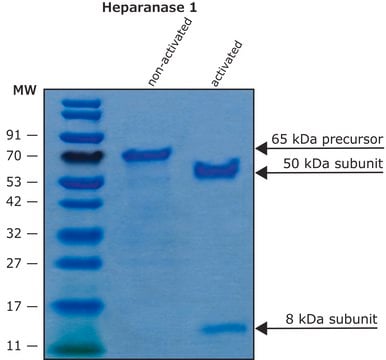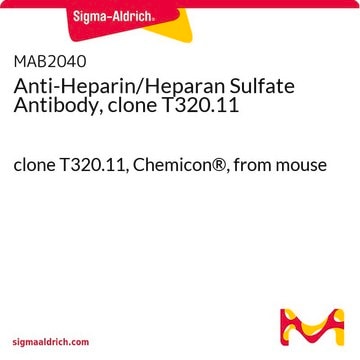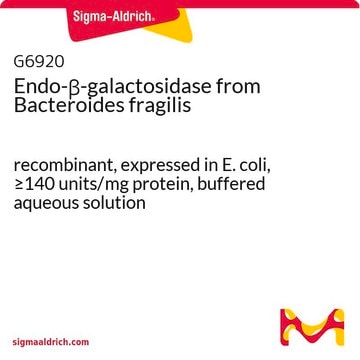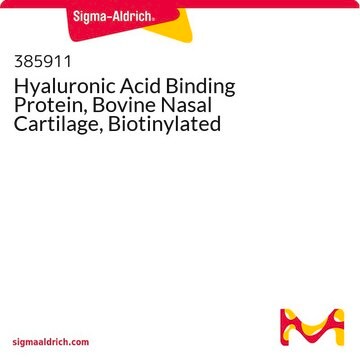H3917
Heparinase I and III Blend from Flavobacterium heparinum
lyophilized powder, stabilized with ∼ 25% (w/w) bovine serum albumin, ≥200 unit/mg protein (enzyme + BSA)
Synonym(s):
Heparinase I and Heparinase III blend
Sign Into View Organizational & Contract Pricing
All Photos(1)
About This Item
Recommended Products
biological source
bacterial (Flavobacterium heparinum)
Quality Level
conjugate
conjugate (Glucosaminoglycan)
form
lyophilized powder
specific activity
≥200 units/mg protein
concentration
≥200 unit/mg protein (enzyme + BSA)
shipped in
dry ice
storage temp.
−20°C
General description
Heparinase is an inducible, non-extracellular heparin-degrading enzyme. Three types of heparinises are produced by Flavobacterium heparinum and contains specific sequences of heparin.
Application
Heparinase I and III Blend from Flavobacterium heparinum has been used in:
- the digestion of heparan sulfate from ovine vitreous
- human embryonic kidney cells
- glycosaminoglycans from arterial tissues
- P0 retinae digestion
Biochem/physiol Actions
Heparinase I and III plays vital role in various biological processes: modulate cell-growth factor interactions, cell-lipoprotein interactions, neovascularization. It cleaves highly sulphated polysaccharide chains in presence of 2-O-sulfated α-L-idopyranosyluronic acid and β-D-glucopyranosyluronic acid residues of polysaccharides.
Heparin-degrading lyase that recognizes heparin sulfate proteoglycan as its primary substrate.
Packaging
Sold on the basis of Heparinase I units
Unit Definition
One unit will form 0.1 micromole of unsaturated uronic acid per hour at 7.5 at 25 degrees C using Heparin, Sodium as substrate for heparinase I.
One unit will form 0.1 micromole of unsaturated uronic acid per hour at 7.5 at 25 degrees C using bovine kidney Heparan, Sulfate as substrate for heparinase III.
One unit will form 0.1 μmole of unsaturated uronic acid per hr at pH 7.5 at 25 °C. One International Unit (I.U.) is equivalent to approx. 600 Sigma units. Package sizes are sold in Sigma units.
One unit will form 0.1 micromole of unsaturated uronic acid per hour at 7.5 at 25 degrees C using bovine kidney Heparan, Sulfate as substrate for heparinase III.
One unit will form 0.1 μmole of unsaturated uronic acid per hr at pH 7.5 at 25 °C. One International Unit (I.U.) is equivalent to approx. 600 Sigma units. Package sizes are sold in Sigma units.
Other Notes
Enzyme Commission Numbers: 4.2.2.7 Hep I and 4.2.2.8 Hep III
Storage Class Code
13 - Non Combustible Solids
WGK
WGK 3
Flash Point(F)
Not applicable
Flash Point(C)
Not applicable
Certificates of Analysis (COA)
Search for Certificates of Analysis (COA) by entering the products Lot/Batch Number. Lot and Batch Numbers can be found on a product’s label following the words ‘Lot’ or ‘Batch’.
Already Own This Product?
Find documentation for the products that you have recently purchased in the Document Library.
Customers Also Viewed
R Sasisekharan et al.
Proceedings of the National Academy of Sciences of the United States of America, 91(4), 1524-1528 (1994-02-15)
Neovascularization is associated with the regulation of tissue development, wound healing, and tumor metastasis. A number of studies have focused on the role of heparin-like molecules in neovascularization; however, little is known about the role of heparin-degrading enzymes in neovascularization.
Retinal proteoglycans act as cellular receptors for basement membrane assembly to control astrocyte migration and angiogenesis
Tao C and Zhang X
Cell Reports, 17(7), 1832-1844 (2016)
IL-2 inducible kinase ITK is critical for HIV-1 infection of Jurkat T-cells
Hain A, et al.
Scientific reports, 8(1), 3217-3217 (2018)
Diffusion regulation in the vitreous humor
Kasdorf B, et al.
Biophysical Journal, 109(10), 2171-2181 (2015)
Glycosaminoglycans contribute to extracellular matrix fiber recruitment and arterial wall mechanics
Mattson JM, et al.
Biomechanics and Modeling in Mechanobiology, 16(1), 213-225 (2017)
Our team of scientists has experience in all areas of research including Life Science, Material Science, Chemical Synthesis, Chromatography, Analytical and many others.
Contact Technical Service











